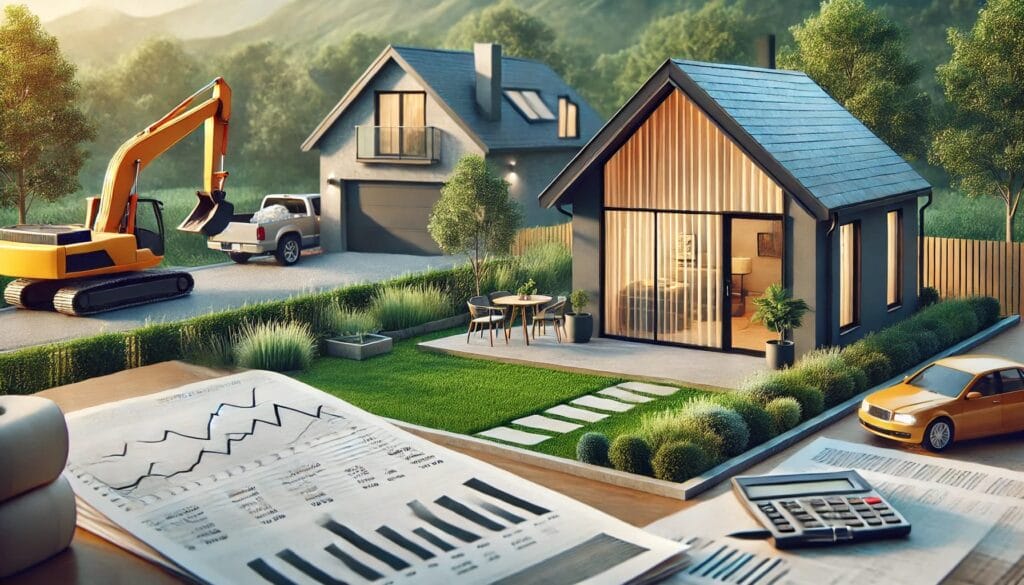As real estate investors seek ways to maximize the value of their properties, adding an accessory dwelling unit (ADU) has become a popular strategy. ADUs provide extra income potential and increase the property’s overall value. However, financing the construction of an ADU, especially on an investment property, can present unique challenges.
I recently spoke with a borrower who is in the process of purchasing an investment property locally in San Diego, California and is looking to build a 1,000 square-foot ADU in the backyard. Below are some terms that could apply in such a scenario.
Borrower’s Scenario:
The borrower is purchasing a single-family home located in San Diego as an investment property. Their goal is to build a 1,000 square-foot ADU in the backyard. A few key points were made clear during our discussion:
- Investment Property Purchase: The borrower is buying an investment property, not a primary or secondary residence.
- Existing Loan: The borrower already has a loan on the investment property, meaning they cannot tap into the equity for the ADU construction.
- Down Payment: The borrower is putting 20% down on the property.
- Estimated ADU Cost: The estimated construction cost for the ADU is between $300,000 and $400,000.
Given these factors, the borrower was looking for guidance on how to finance the ADU: Is it financed like a regular investment property, or are there unique financing options available for these types of projects?
Key Considerations for Financing an ADU on an Investment Property:
- Second Mortgage: One of the most viable options for financing the construction of an ADU is through a second mortgage. Since the borrower already has a loan on the property and can’t pull out any equity, a second mortgage provides a separate loan that specifically funds the ADU project.
- Loan to Cost Ratio: In this scenario, the loan would likely cover 80% of the total project cost. For an ADU project costing between $300,000 and $400,000, the loan would provide between $240,000 and $320,000, with the borrower needing to cover the remaining 20% through their own funds.
- Personal Guarantee: Since the borrower is building an ADU on an investment property, many lenders require a personal guarantee. This means the borrower is personally responsible for repaying the loan, providing the lender with additional security.
- Future Value Appraisal: Financing for ADU construction often involves a future value appraisal. This type of appraisal estimates the value of the property after the ADU is built, allowing lenders to understand the potential return on investment and the increased value of the property. The borrower is typically responsible for covering the cost of this appraisal.
- Interest and Draw Periods: ADU construction loans typically come with specific draw periods, meaning the borrower only pays interest on the money as it’s drawn out in stages throughout the construction process. In this case, there would be two draw periods, which helps keep initial interest payments lower, as you’re only charged interest on the funds drawn at each stage.
- Loan Terms: The proposed loan would have a 12-month term, during which time the ADU construction should be completed. Once finished, the borrower could look to refinance the first mortgage and include the cost of the ADU, effectively paying off the construction loan. If construction extends beyond the initial term, a 3-month extension may be available, though this would come at an additional cost.
- Flat Fee: A $10,000 flat fee would be charged to the borrower for the loan, paid directly to the lender. This is typical in construction loans where additional services, such as draw management and oversight, are involved.
- Permits: It’s crucial to have all permits in place before any funding is released. This ensures the construction can legally proceed and minimizes delays that could impact the overall financing structure.
- Mandatory Use of Specific Contractors: In this case, we have a stipulation that the borrower must use Snap ADU, a recognized company specializing in accessory dwelling units. This requirement ensures the project is executed by a reputable builder who understands the nuances of ADU construction and adheres to the timeline and quality standards that our investors require.
- Credit Score Requirements: Given the nature of the project and the financing structure, the borrower needs a minimum credit score of 720. This ensures that the borrower has a solid financial standing and reduces the risk for the lender.
Benefits of This Financing Structure:
- Tailored for ADU Construction: This financing structure is specifically designed for projects like ADU construction, addressing unique factors such as the need for multiple draw periods and future value appraisals.
- Interest Savings: Since interest is only charged on the outstanding draws, the borrower can save on interest payments during the initial stages of construction.
- Flexibility: The loan offers flexibility in terms of extensions, and the ability to refinance once the ADU is complete helps to roll everything into a single mortgage down the line.
Conclusion:
Financing the construction of an ADU on an investment property presents unique challenges, but there are specific financing options designed to accommodate these projects. In the borrower’s case, a second mortgage with 80% loan-to-cost financing, personal guarantee, future value appraisal, and a 12-month term with flexible draw periods makes the most sense. By ensuring all permits are in place and working with a reputable ADU contractor, the borrower can move forward confidently with their ADU project, maximizing the value of their investment property.
As always, it’s essential to discuss all terms and conditions with us beforehand to fully understand the obligations and requirements throughout the construction and repayment process.


